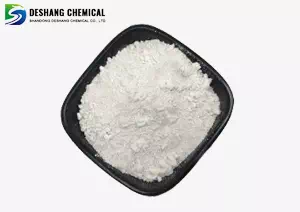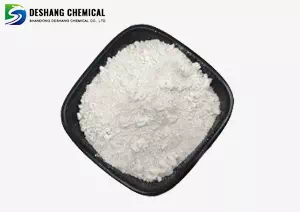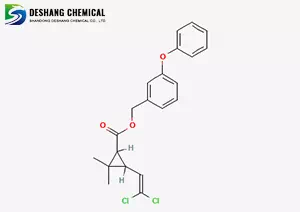All Categories



Permethrin CAS 52645-53-1, Permethrin, CAS 52645-53-1
Chemical name: (3-phenoxyexybenzyl) methyl cis-trans -3-(2, 2-dichloroyl)-2, 2-dimethylcyclopropane carboxylate ester
CAS : 52645-53-1
Formula : C21H20Cl2O3
Mol. wt. : 391.29
EINECS : 258-067-9
| CAS | 52645-53-1 |
| Molecular formula | C21H20Cl2O3 |
| Molecular weight | 391.29 |
| EIENCS | 258-067-9 |
| Form | neat |
| Melting point | 34-35°C |
| boling point | bp0.05 220°C |
| Density | 1.19 |
| Solubility | insoluble |
| PKA | / |
| Color | / |
| Storage temp | 0-6°C |
Molecular formula and structure
Molecular formula: C₂₁H₂₀Cl₂O₃
Molecular weight: 391.29 g/mol
Chemical name: (3-phenoxyexybenzyl) methyl cis-trans -3-(2, 2-dichloroyl)-2, 2-dimethylcyclopropane carboxylate ester
Structural features: A pyrethroid insecticide without cyano groups, containing benzene rings, dichloroethylene groups and cyclopropane carboxylic acid ester structures.
Appearance: The pure product is a colorless crystal (melting point 34-35℃), while the industrial product is a brownish-yellow viscous liquid or semi-solid with a density of 1.19-1.27g /cm³ at 20℃.
Operation and storage specifications
Usage requirements
Avoid mixing with alkaline substances (such as lime); Prepare and use immediately to prevent hydrolysis and failure.
Safety interval: 7 days for tea and 21 days for cotton.
Storage conditions
Seal and keep away from light, humidity <60%, temperature <25℃ (shelf life: 2 years).
First aid measures
Skin contact → Rinse with soapy water for 15 minutes; Eye contact → Rinse with normal saline + Seek medical attention; Accidental ingestion → Gastric lavage and symptomatic treatment.
1. Agricultural pest control
Applicable crops: cotton, vegetables, fruit trees, tea trees, etc.
Target pests
Cotton bollworm (10% emulsifiable concentrate 1000-1250 times dilution), cabbage worm (1000-2000 times dilution), tea looper (2500-5000 times dilution).
Advantages: Fast knockdown speed, long-lasting effect (>60 days), and relatively slow development of pest resistance.
2. Hygiene and Pest Control in Livestock
Sanitary pests: Mosquitoes, flies, cockroaches (10% emulsifiable concentrate 0.01-0.03 ml/m³ residual spray).
Livestock application
Prevention and control of external parasites in animals (such as wool mothproofing, with an addition amount of 200 mg/kg).
Textile mosquito repellent treatment (US EPA certified, for military uniforms).
3. Disabled scenarios:
Rice fields, flowering crops, and beekeeping areas (highly toxic to aquatic organisms and bees).
1. Toxicity data
Mammals
Acute oral LD₅₀ in rats: 430-4000 mg/kg (due to differences in isomer ratios).
Acute percutaneous LD₅₀ in rabbits: >2000 mg/kg; Mild eye irritation, no skin sensitization.
Carcinogenicity: Classified as a Group 3 carcinogen by the WHO (insufficient evidence).
Ecological toxicity
Fish: Rainbow trout LC₅₀ (96h) 0.0032 mg/L (highly toxic).
Bees: Exposure LD₅₀ 0.029 μg per bee (highly toxic).
Birds: Quail LD₅₀ >13,500 mg/kg (low toxicity).
2. Human exposure risk
Route of contact: Skin/Respiratory tract/digestive tract; It has low lipid solubility and is not easily absorbed through the skin.
Acute symptoms
Skin tingling, redness and swelling (no erythema); Nausea, diarrhea and convulsions caused by accidental ingestion; Inhalation causes pulmonary edema.
Protective requirements
When operating, wear a full-face gas mask, nitrile gloves, goggles and anti-static clothing.
In case of leakage, adsorb with sand and soil and incinerate (do not discharge into water bodies).
* Prompt reply and 24 hours online, professional team to provide best price and high quality product.
* Sample testing support.
* Every batch of products will be tested to ensureits quality.
*The packing also can be according the customers` requirment.
*Any inquiries will be replied within 24 hours.
*we provide Commerical Invoice, Packing List, Bill of loading, COA , Health certificate and Origin certificate. If your markets have any special requirements, let us know.